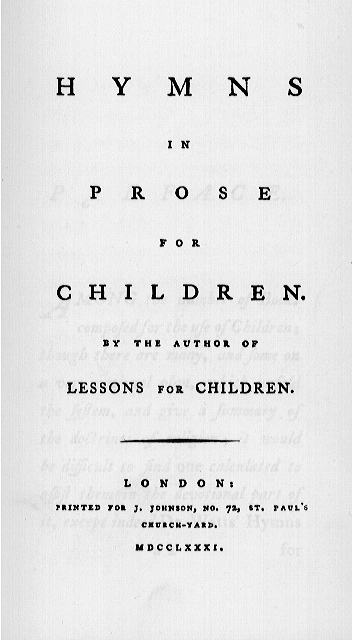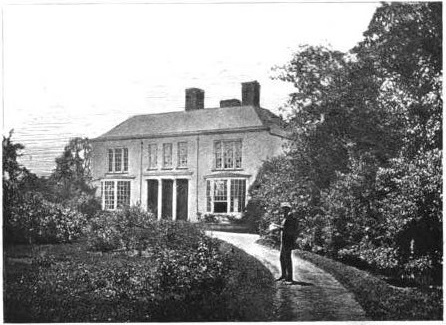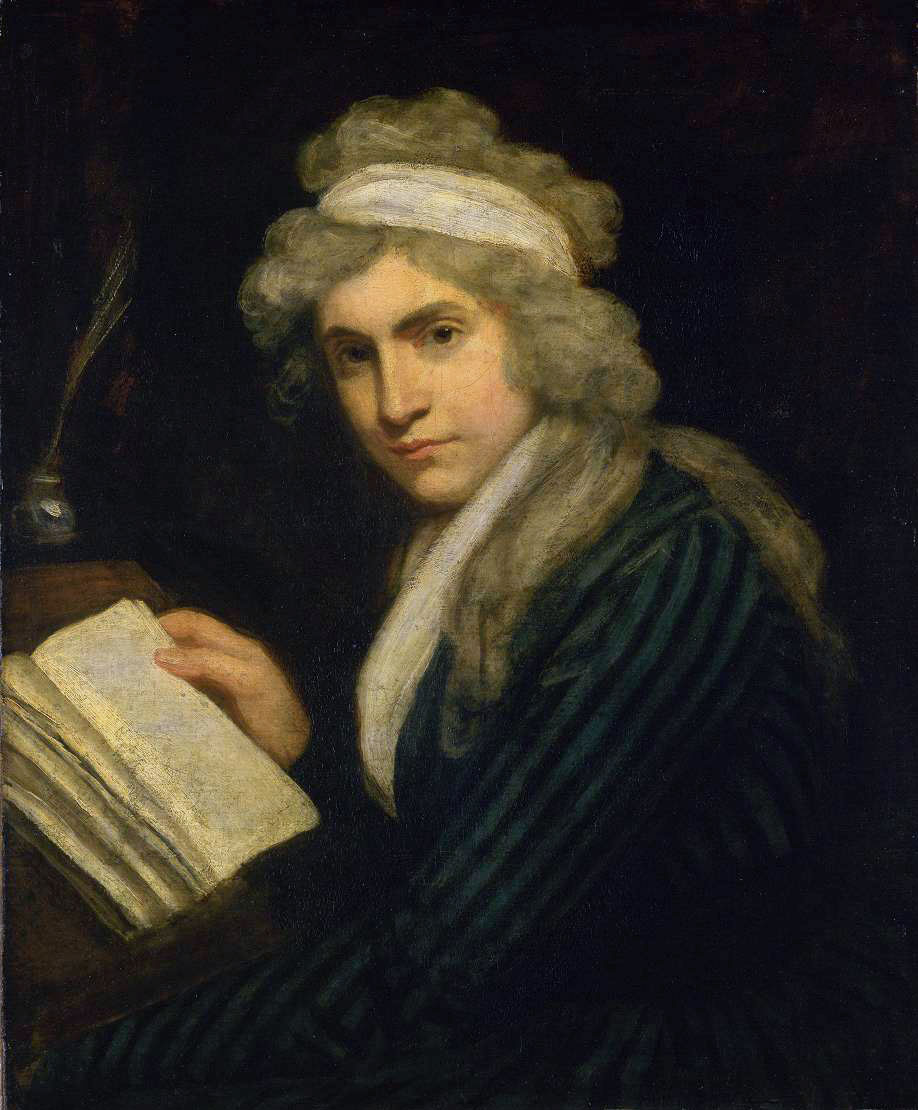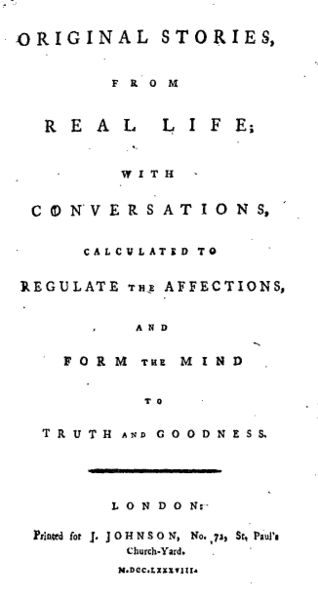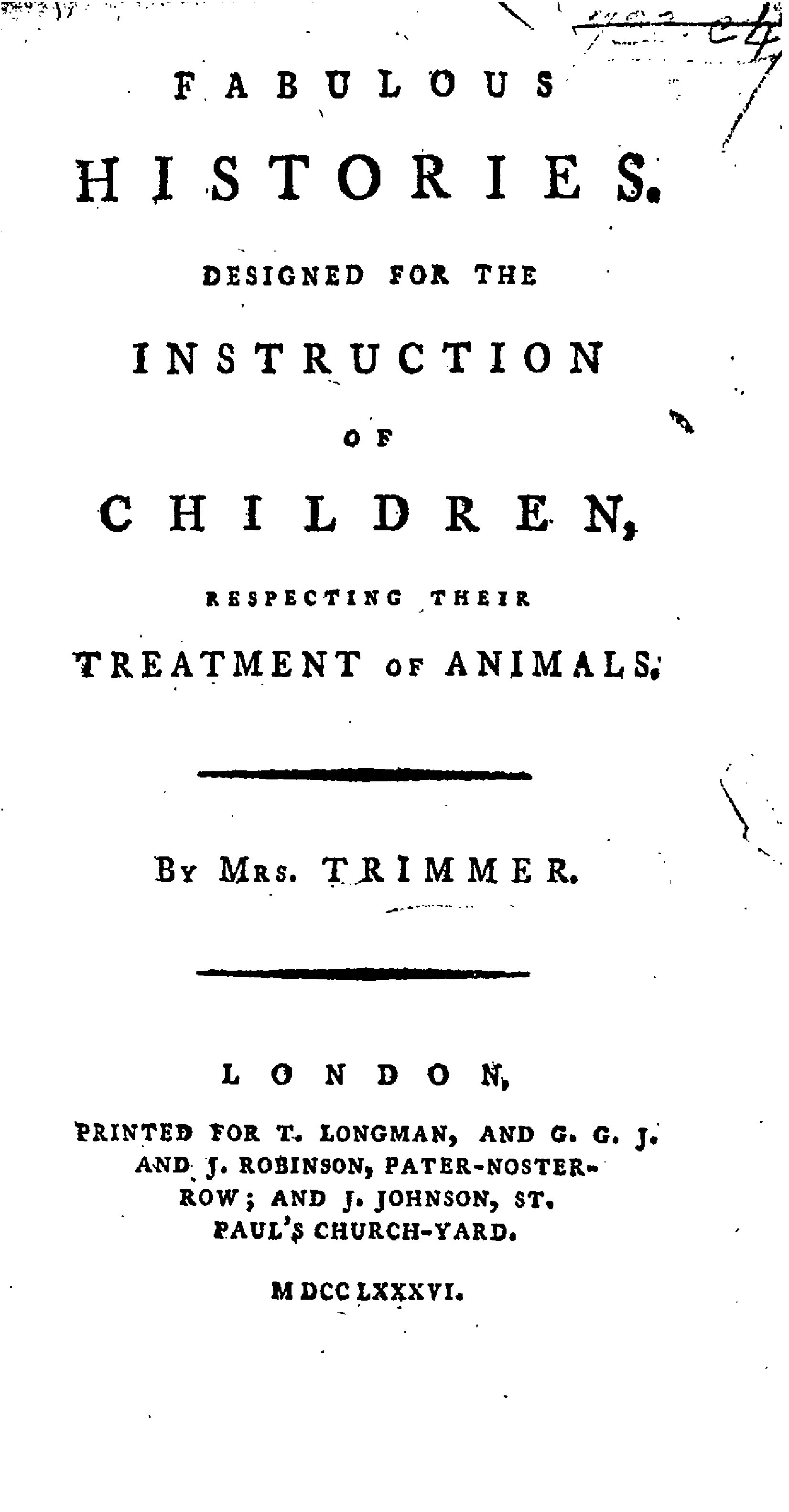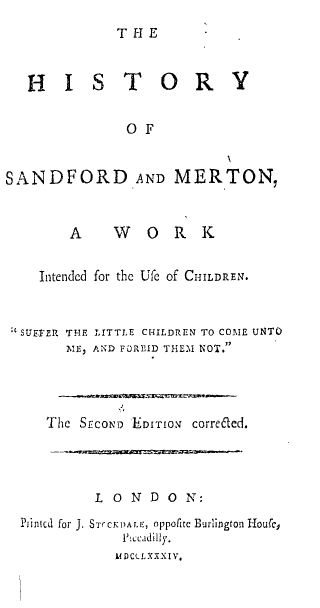|
List Of 18th-century British Children's Literature Titles
This is a list of 18th-century British children's literature titles (ordered by year of publication): * '' Divine Songs'' (1715) by Isaac Watts * ''A Description of Three Hundred Animals'' (1730) by Thomas Boreman * ''The Gigantick History of the Two Famous Giants'' (1730) by Thomas Boreman * ''A Little Pretty Pocket-Book'' (1744) published by John Newbery * ''The Governess, or The Little Female Academy'' (1749) by Sarah Fielding * ''The History of Little Goody Two-Shoes'' (1765) published by John Newbery * '' The Parables of Our Lord and Saviour Jesus Christ'' (1768) by Christopher Smart * ''Hymns for the Amusement of Children'' (1771) by Christopher Smart * '' Lessons for Children'' (1778–79) by Anna Laetitia Barbauld * '' An Easy Introduction to the Knowledge of Nature'' (1780) by Sarah Trimmer * ''Hymns in Prose for Children'' (1781) by Anna Laetitia Barbauld * '' Sacred Dramas'' by Hannah More * ''The Life and Perambulation of a Mouse'' (1783) by Dorothy Kilner * ''Cobwebs t ... [...More Info...] [...Related Items...] OR: [Wikipedia] [Google] [Baidu] |
Children's Literature
Children's literature or juvenile literature includes stories, books, magazines, and poems that are created for children. Modern children's literature is classified in two different ways: genre or the intended age of the reader. Children's literature can be traced to traditional stories like fairy tales, that have only been identified as children's literature in the eighteenth century, and songs, part of a wider oral tradition, that adults shared with children before publishing existed. The development of early children's literature, before printing was invented, is difficult to trace. Even after printing became widespread, many classic "children's" tales were originally created for adults and later adapted for a younger audience. Since the fifteenth century much literature has been aimed specifically at children, often with a moral or religious message. Children's literature has been shaped by religious sources, like Puritan traditions, or by more philosophical and scienti ... [...More Info...] [...Related Items...] OR: [Wikipedia] [Google] [Baidu] |
Hymns In Prose For Children
''Hymns in Prose for Children'' (1781) is a children's book by Anna Laetitia Barbauld. Biographical background Barbauld and her husband were concerned that they would never have a child of their own and in 1775, after only a year of marriage, Barbauld suggested to her brother, John Aikin, that they adopt one of his children: Eventually her brother conceded and the couple adopted Charles; it was for him that Barbauld wrote her most famous books: '' Lessons for Children'' (1778–9) and ''Hymns in Prose for Children'' (1781). Literary analysis Barbauld’s '' Lessons for Children'' and ''Hymns in Prose for Children'' were a revolution in children’s literature. For the first time, the needs of the child reader were seriously considered. Barbauld demanded that her books be printed in large type with wide margins so that children could easily read them and, even more importantly, she developed a style of “informal dialogue between parent and child” that would dominate childre ... [...More Info...] [...Related Items...] OR: [Wikipedia] [Google] [Baidu] |
Maria Edgeworth
Maria Edgeworth (1 January 1768 – 22 May 1849) was a prolific Anglo-Irish novelist of adults' and children's literature. She was one of the first realist writers in children's literature and was a significant figure in the evolution of the novel in Europe. She held views on estate management, politics and education, and corresponded with some of the leading literary and economic writers, including Sir Walter Scott and David Ricardo. Life Early life Maria Edgeworth was born at Black Bourton, Oxfordshire. She was the second child of Richard Lovell Edgeworth (who eventually fathered 19 children by four wives) and Anna Maria Edgeworth (''née'' Elers); Maria was thus an aunt of Francis Ysidro Edgeworth. She spent her early years with her mother's family in England, living at The Limes (now known as Edgeworth House) in Northchurch, by Berkhamsted in Hertfordshire. Her mother died when Maria was five, and when her father married his second wife Honora Sneyd in 1773, she went with ... [...More Info...] [...Related Items...] OR: [Wikipedia] [Google] [Baidu] |
The Parent's Assistant
''The Parent's Assistant'' is the first collection of children's stories by Maria Edgeworth, published by Joseph Johnson in 1796. Contents The first edition (Part I) had five stories: ''Lazy Lawrence'', ''Tarlton'', ''The Little Dog Trusty,'' ''The Orange Man'' and ''The False Key''. ''Barring Out'' was included in the second edition of Part I published the same year. In later editions more material was added, most notably, "The Purple Jar", and a play for children, ''Old Poz''. The 1865 American edition contained the following stories: "Lazy Lawrence", "Tarlton", "The False Key", "The Birthday Present", "Simple Susan", "The Bracelets", "The Little Merchants", "Old Poz", "The Mimic", "Mademoiselle Panache", "The Basket Woman", "The White Pigeon", "The Orphans", "Waste Not, Want Not", "Forgive and Forget", "The Barring Out, or Party Spirit", and "Eton Montem". Influence Queen Victoria was reading ''The Parent's Assistant'' in 1837, just three months before her coronation. She ... [...More Info...] [...Related Items...] OR: [Wikipedia] [Google] [Baidu] |
Mary Wollstonecraft
Mary Wollstonecraft (, ; 27 April 1759 – 10 September 1797) was a British writer, philosopher, and advocate of women's rights. Until the late 20th century, Wollstonecraft's life, which encompassed several unconventional personal relationships at the time, received more attention than her writing. Today Wollstonecraft is regarded as one of the founding feminist philosophers, and feminists often cite both her life and her works as important influences. During her brief career, she wrote novels, treatises, a travel narrative, a history of the French Revolution, a conduct book, and a children's book. Wollstonecraft is best known for ''A Vindication of the Rights of Woman'' (1792), in which she argues that women are not naturally inferior to men, but appear to be only because they lack education. She suggests that both men and women should be treated as rational beings and imagines a social order founded on reason. After Wollstonecraft's death, her widower published a ''Memoir ... [...More Info...] [...Related Items...] OR: [Wikipedia] [Google] [Baidu] |
Original Stories From Real Life
''Original Stories from Real Life; with Conversations Calculated to Regulate the Affections, and Form the Mind to Truth and Goodness'' is the only complete work of children's literature by the 18th-century English feminist author Mary Wollstonecraft. ''Original Stories'' begins with a frame story that sketches out the education of two young girls by their maternal teacher Mrs. Mason, followed by a series of didactic tales. The book was first published by Joseph Johnson in 1788; a second, illustrated edition, with engravings by William Blake, was released in 1791 and remained in print for around a quarter of a century. In ''Original Stories'', Wollstonecraft employed the then-burgeoning genre of children's literature to promote the education of women and an emerging middle-class ideology. She argued that women would be able to become rational adults if they were educated properly as children, which was not a widely held belief in the 18th century, and contended that the nascent m ... [...More Info...] [...Related Items...] OR: [Wikipedia] [Google] [Baidu] |
Fabulous Histories
''Fabulous Histories'' (later known as ''The Story of the Robins''), is the best-known work of Sarah Trimmer. Originally published in 1786, it remained in print until the beginning of the twentieth century. Plot ''Fabulous Histories'' tells the story of two families—one of robins and one of humans—who learn to live together congenially. The children and baby robins learn to adopt virtue and to shun vice. For Trimmer, practising kindness to animals as a child would hopefully lead one to "universal benevolence" as an adult. According to Samuel Pickering Jr., a scholar of eighteenth-century children's literature, "in its depiction of eighteenth-century attitudes toward animals, Mrs. Trimmer’s ''Fabulous Histories'' was the most representative children’s book of the period." Thematic elements The text expresses several themes that would dominate Trimmer's later works, such as her emphasis on retaining social hierarchies; as Tess Cosslett, a scholar of children's literature ... [...More Info...] [...Related Items...] OR: [Wikipedia] [Google] [Baidu] |
Thomas Day (writer)
Thomas Day (22 June 1748 – 28 September 1789) was a British author and abolitionist. He was well known for the book ''The History of Sandford and Merton'' (1783–1789) which emphasized Rousseauvian educational ideals, for his writings against slavery, for campaigning both for and against American independence, and for his project applying his educational ideals to young girls with the aim of raising a wife for himself. Early life Day was born on 22 June 1748 in London, the only child of Thomas and Jane Day. His father died when he was about a year old, but left him wealthy. He first attended a school in Stoke Newington, Middlesex, where the family lived at what is now 109-111 Church Street, but after a bout of smallpox which left his face permanently scarred he was moved to Charterhouse School. He subsequently attended Corpus Christi College, Oxford, where he became a master debater and developed a close friendship with William Jones; he did not graduate and left the col ... [...More Info...] [...Related Items...] OR: [Wikipedia] [Google] [Baidu] |
The History Of Sandford And Merton
''The History of Sandford and Merton'' (1783–89) was a best-selling children's book written by Thomas Day. He began it as a contribution to Richard Lovell and Honora Sneyd Edgeworth's ''Harry and Lucy'', a collection of short stories for children that Maria Edgeworth continued some years after her stepmother died. He eventually expanded his original short story into the first volume of ''The History of Sandford and Merton'', which was published anonymously in 1783; two further volumes subsequently followed in 1786 and 1789. The book was wildly successful and was reprinted until the end of the nineteenth century.Darton, F. J. Harvey. ''Children's Books in England: Five Centuries of Social Life''. 3rd ed. Rev. Brian Alderson. Cambridge: Cambridge University Press (1982), 146. It retained enough popularity or invoked enough nostalgia at the end of the nineteenth century to inspire a satire, ''The New History of Sandford and Merton'', whose preface proudly announces that it will "t ... [...More Info...] [...Related Items...] OR: [Wikipedia] [Google] [Baidu] |
Ellenor Fenn
Ellenor Fenn ( Frere; 1743–1813; pseudonyms, Mrs. Teachwell, Mrs. Lovechild) was a prolific 18th-century British writer of children's books. Early life Ellenor Frere was born on 12 March 1743/44 in Westhorpe, Suffolk to Sheppard and Susanna Frere. John Frere was her elder brother and John Hookham Frere her nephew. In 1766, she married the antiquarian John Fenn and moved with him to Hill House, Dereham, Norfolk. Although they had no biological children, they adopted and brought up an orphaned heiress, Miss Andrews.Stoker, "Ellenor Fenn". Career Fenn wrote a series of children's books for her nephews and nieces, inspired by Anna Laetitia Barbauld's '' Lessons for Children'' (1778-9), and in 1782 she wrote to the children's publisher John Marshall asking whether he would be willing to publish them. Between 1782 and 1812, he published numerous books by Fenn, often anonymously or under the pseudonyms Mrs. Teachwell or Mrs. Lovechild. ''Cobwebs to Catch Flies'' (1783), a reading p ... [...More Info...] [...Related Items...] OR: [Wikipedia] [Google] [Baidu] |
Cobwebs To Catch Flies
''Cobwebs to Catch Flies'' (1783) is a children's book by Ellenor Fenn, originally anonymous, but later editions were advertised as being by ''Mrs Teachwell'' or "Mrs Lovechild". It was a reading primer and was one of the first books to differentiate between reading age groups, and which was widely used until the 1890s. Description The work was originally published in two volumes – one for children from three to five years, and the second for those from five and eight, but later editions combined them into one. It consisted of a series of short, illustrated dialogues between children, teaching basic reading skills. It was an innovative book in several respects as it focused on the child reader’s own experience and interests, including toys, pets, games, visits to the fair etc., and was one of the first books to differentiate between reading age groups; each volume became progressively more difficult as the child progressed. The early editions were printed in large types c ... [...More Info...] [...Related Items...] OR: [Wikipedia] [Google] [Baidu] |
Dorothy Kilner
Dorothy Kilner (17 February 1755 – 5 February 1836), who used the pseudonyms M. P. and Mary Pelham, was a prolific English writer of children's books. She combined a didactic approarch with a strong knowledge of children's character.Patricia Wright: Kilner, Dorothy (1755–1836). In: ''Oxford Dictionary of National Biography'', online e. (Oxford: Oxford University Press, September 2004)Retrieved 8 September 2010./ref> Her best known work was ''The Life and Perambulation of a Mouse'' (1784). Life Dorothy was born on 17 February 1755, probably at Woodford, Essex as the youngest of five children of Thomas Kilner (1719–1804), public servant and landowner, and his wife, Frances, née Ayscough (1718–1768). The family moved to Maryland Point, then in Essex, in 1759. Kilner was much inspired by a friendship that began in childhood with Mary Ann Maze (Mary Ann Kilner, 1753–1831). This involved exchanging copious verse letters on religious and personal matters. When Maze marrie ... [...More Info...] [...Related Items...] OR: [Wikipedia] [Google] [Baidu] |
.jpg)
